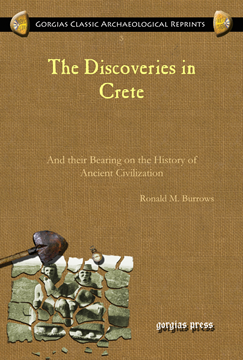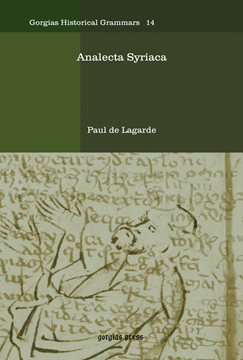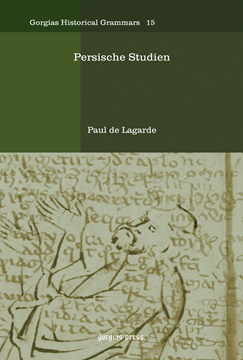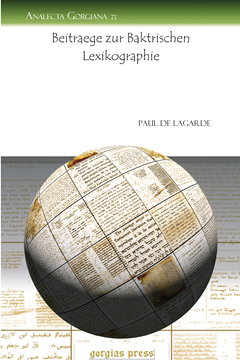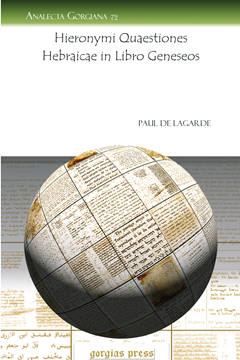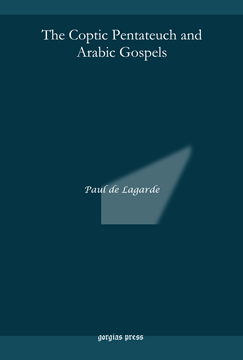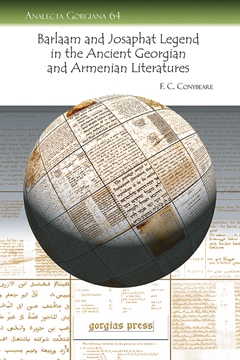The Discoveries in Crete
And their Bearing on the History of Ancient Civilization
Series: Kiraz Classic Archaeological Reprints 3
ISBN: 978-1-59333-955-5
Indeed a classic of accessible archaeological writing, Burrows’ study of ancient Crete was one of the main contributors to the commencement of modern understanding of the Minoans. The earliest traces of the Minoan civilization are sketched out before he turns to the historical periods when Minos flourished. The sack of Knossos and the end of the Bronze Age are narrated against the archaeological background. Aware of the cultural continuity of classical stories from the island, he introduces the topic of the minotaur and the famed labyrinth of Knossos. For anyone interested in the roots of western civilization, or of the founding of classical civilizations, this book remains an essential reading.
$149.00 (USD) $89.40 (USD)
Analecta Syriaca
Series: Kiraz Historical Grammars Archive 14
ISBN: 978-1-59333-959-3
A rare edition of Lagarde’s Syriac ephemera, this volume is a linguist’s delight. Introduced in Latin and Arabic, the descriptions and annotations to Syriac manuscripts that constitute this book will seldom be found elsewhere. The various Syriac codices included in the collection are presented in Syriac without translation. For the student of Syriac who is seeking the authentic experience of reading Syriac materials, this study will be a treasury of material. Over the decades, Legarde’s works have become increasingly difficult to locate, and Gorgias Press is pleased to be able to offer this collectable again.
$148.00 (USD) $88.80 (USD)
Persische Studien
Series: Kiraz Historical Grammars Archive 15
ISBN: 978-1-59333-960-9
The astute observations of linguist Paul de Lagarde on Persian manuscript in Europe predating 1700 make an essential catalogue for anyone interested in the state of the field in the late 19th century. Citing each manuscript, Lagarde provides an annotated catalogue of 61 pieces that include descriptions from the initial publication of each text as well as his own observations. His study gives a sense of importance of each piece considered, demonstrating their relationships with other known documents. Also included in this unique study are the Judeo-Persian versions of the prophets Isaiah, Jeremiah, and Ezekiel (the latter only through chapter 9).
$136.00 (USD) $81.60 (USD)
Materialien zur Kritik und Geschichte des Pentateuchs
ISBN: 978-1-59333-962-3
Originally published in two volumes, this edition of the Arabic translation of the Pentateuch stands as one of Lagarde’s lasting contributions to biblical scholarship. Critical editions make frequent reference to this work. Included are two translations of Genesis into Arabic, along with a single version of the remaining pentateuchal books, also in Arabic. The first translation of Genesis represents the tradition of the Paris Polyglot, translated directly from the Hebrew, while the second is a cantena text from the Syriac tradition, representing two-thirds of Genesis. Lagarde’s study provides a valuable text-critical tool and easy access to the Arabic versions of the material.
$189.00 (USD) $113.40 (USD)
Beitraege zur Baktrischen Lexikographie
Series: Analecta Gorgiana 71
ISBN: 978-1-59333-963-0
One of the few scholars of biblical languages to reach so far into the cultural world of antiquity, de Lagarde here offers a brief contribution to the study of Bactrian lexicography. This brief study grew out of the author’s long-standing appreciation for the related Persian languages and literature. While not a full-fledged dictionary, de Lagarde here provides discussions of over one hundred words, some of them offered in considerable detail. For the linguist interested in the history of the study of this particular language, this handbook will prove an invaluable tool.
$48.00 (USD) $28.80 (USD)
Hieronymi Quaestiones Hebraicae in Libro Geneseos
Series: Analecta Gorgiana 72
ISBN: 978-1-59333-964-7
Written in the scholarly Latin of his day, Lagarde considers in this brief study the questions Jerome raises on the Hebrew of the book of Genesis. In an abridged commentary form, Lagarde follows the questions in the order in which the book of Genesis presents the material. Beginning with the creation, Lagarde skips along to the phrases of Jerome’s text that raise questions and provides his insights about them. Presuming that the reader of the Vulgate will understand the Latin of the original, the comments on the material are likewise written in Latin.
$48.00 (USD) $28.80 (USD)
The Coptic Pentateuch and Arabic Gospels
ISBN: 978-1-59333-965-4
Written in the days when textual criticism was still relatively new, and the great mass of manuscripts commonly used by present-day biblical scholars had not yet been plumbed, Lagarde spent many years making these exotic manuscripts available to scholars who previously had no access to them. In this volume are combined two manuscripts: the Pentateuch translated into Coptic, and the Gospels translated into Arabic. Despite the relatively recent dates of the manuscript sources for both collections, the material contained in these translations dates back to earlier days. Each of these translations is introduced in German with some critical notes about the readings included.
$260.00 (USD) $156.00 (USD)
The Early Syriac Lectionary
Series: Analecta Gorgiana 62
ISBN: 978-1-59333-878-7
This piece provides an introduction, translation and commentary to a previously unstudied lectionary text, which provides deeper insight into early liturgical practice and the conception of the canon; and includes an index of the lessons according to books of Scripture.
$41.00 (USD) $24.60 (USD)
Megillat Taanit as a Source for Jewish Chronology and History in the Hellenistic and Roman Periods
Series: Analecta Gorgiana 63
ISBN: 978-1-59333-879-4
Zeitlin’s masterful work supplies the Megillat Taanit’s text and a translation as well as a deft reading of this source’s utility for the history of the Jews from the Maccabees to the Great Revolt.
$59.00 (USD) $35.40 (USD)
The Barlaam and Josaphat Legend in the Ancient Georgian and Armenian Literatures
Series: Analecta Gorgiana 64
ISBN: 978-1-59333-880-0
This work focuses on the literary and textual concerns of the Georgian and Armenian recensions of the Barlaam and Josaphat legend, and provides translations of all that remains of the Georgian text and the relevant Armenian parallels.
$41.00 (USD) $24.60 (USD)
